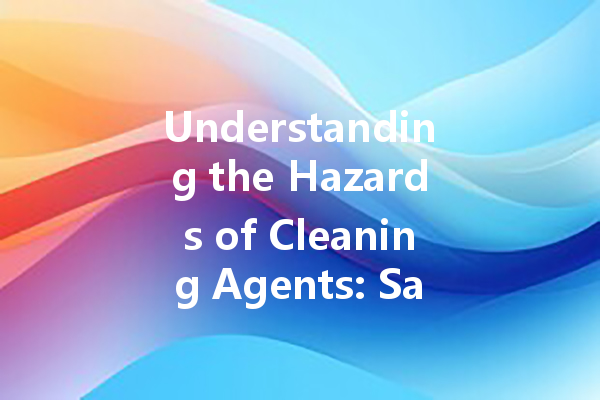Reinigungsmittel sind ein fester Bestandteil unseres täglichen Lebens. Ob im Haushalt oder in der Industrie, diese Produkte helfen, Sauberkeit und Hygiene zu erhalten. Viele Reinigungsmittel enthalten jedoch Chemikalien, die bei unsachgemäßem Umgang erhebliche Gesundheitsrisiken bergen können. Dieser Artikel befasst sich mit den potenziellen Gefahren, die von Reinigungsmitteln ausgehen, und gibt wichtige Sicherheitstipps für deren Verwendung.
Die allgemeinen Gefahren von Reinigungsmitteln
Viele Reinigungsmittel enthalten scharfe Chemikalien, die zu verschiedenen gesundheitlichen Problemen führen können. Zu den üblichen Gefahren gehören:
Chemische Verbrennungen
Einige Reinigungsmittel, insbesondere starke Entfetter und Backofenreiniger, können bei Hautkontakt chemische Verbrennungen verursachen. Die Schwere der Verbrennung hängt von der Konzentration der Chemikalie und der Dauer der Einwirkung ab.
Probleme mit den Atemwegen
Viele Reinigungsmittel setzen flüchtige organische Verbindungen (VOC) in die Luft frei, die Atemprobleme verursachen können. Eine längere Exposition kann zu chronischen Gesundheitsproblemen wie Asthma oder chemischen Empfindlichkeiten führen.
Augenreizung
Versehentliche Spritzer von Reinigungsmitteln in die Augen können Reizungen oder schwere Schäden verursachen. Viele Reinigungsmittel sind mit Warnhinweisen versehen, die darauf hinweisen, dass sie schwere Augenreizungen verursachen können.
Risiken bei Verschlucken
Das Verschlucken von Reinigungsmitteln, sei es versehentlich oder durch unsachgemäße Anwendung, birgt ernsthafte Gesundheitsrisiken. Viele Produkte sind giftig und können zu Vergiftungen führen, die sofortige ärztliche Hilfe erfordern.
Verstehen von Etiketten und Sicherheitsdatenblättern (SDS)
Bevor Sie ein Reinigungsmittel verwenden, sollten Sie sich unbedingt mit den Angaben auf den Etiketten über mögliche Gefahren vertraut machen.
Die Bedeutung von Etiketten
Die Etiketten von Reinigungsmitteln enthalten wichtige Informationen über Sicherheit und Verwendung. Achten Sie auf:
Sicherheitsdatenblätter (SDS)
Sicherheitsdatenblätter bieten detaillierte Informationen über die Gesundheitsrisiken, die mit bestimmten Reinigungsmitteln verbunden sind. Sie umfassen:
Wichtige Sicherheitstipps für die Verwendung von Reinigungsmitteln
Um die mit Reinigungsmitteln verbundenen Risiken zu minimieren, sollten Sie die folgenden Sicherheitstipps beachten:
Tragen Sie persönliche Schutzausrüstung (PSA)
Die Verwendung geeigneter PSA kann Sie vor einer Exposition schützen. Dazu können Handschuhe, Schutzbrillen und Masken gehören. Achten Sie immer darauf, dass die PSA für die verwendeten Chemikalien geeignet ist.
Richtige Belüftung sicherstellen
Achten Sie bei der Verwendung von Reinigungsmitteln in Innenräumen darauf, dass der Raum gut belüftet ist. Öffnen Sie die Fenster, verwenden Sie Abluftventilatoren oder erwägen Sie den Einsatz von Luftreinigern, um die Konzentration schädlicher Dämpfe zu verringern.
Dosierungsanweisungen befolgen
Die Verwendung von mehr Reinigungsmitteln als empfohlen ist nicht gleichbedeutend mit einem besseren Reinigungsergebnis. Vielmehr kann dies die Gefahren erhöhen. Befolgen Sie stets die Anweisungen des Herstellers zur richtigen Dosierung.
Reinigungsmittel sicher lagern
Bewahren Sie Reinigungsmittel außerhalb der Reichweite von Kindern und Haustieren auf. Bewahren Sie sie in ihren Originalbehältern mit intaktem Etikett auf. Stellen Sie sicher, dass sie an einem kühlen, trockenen Ort gelagert werden, um das Risiko von Verschüttungen oder Reaktionen zu minimieren.
Vermeiden Sie das Mischen von Chemikalien
Das Mischen verschiedener Reinigungsmittel kann zu gefährlichen chemischen Reaktionen führen. Wenn Sie zum Beispiel Bleichmittel mit Ammoniak mischen, entstehen giftige Chloramindämpfe. Verwenden Sie immer nur ein Produkt auf einmal.
Was ist im Falle einer Exposition zu tun?
Wenn Sie oder eine andere Person mit einem Reinigungsmittel in Berührung gekommen sind, kann das Wissen um die richtigen Schritte schwerwiegende Folgen verhindern.
Chemische Verbrennungen
Wenn ein Reinigungsmittel mit der Haut in Berührung kommt, spülen Sie den Bereich mindestens 15 Minuten lang mit reichlich Wasser ab. Ziehen Sie kontaminierte Kleidung aus und suchen Sie bei Bedarf einen Arzt auf.
Exposition der Augen
Bei Spritzern in die Augen sofort mindestens 15 Minuten lang unter fließendem Wasser ausspülen. Vermeiden Sie es, die Augen zu reiben und suchen Sie umgehend einen Arzt auf.
Verschlucken
Bei Verschlucken eines Reinigungsmittels kein Erbrechen herbeiführen, es sei denn, es liegt eine ärztliche Anweisung vor. Rufen Sie den Giftnotruf an oder suchen Sie sofort ärztliche Hilfe auf.
Schlussfolgerung
Reinigungsmittel sind zwar unverzichtbare Hilfsmittel für eine saubere Umgebung, bergen aber auch Gefahren in sich. Wenn Sie die potenziellen Risiken kennen und die Sicherheitsprotokolle befolgen, können Sie die Reinigung für sich und Ihre Angehörigen sicherer gestalten. Geben Sie der Sicherheit stets den Vorrang und halten Sie sich an die Richtlinien, um die negativen Auswirkungen der Chemikalienexposition zu mindern.

